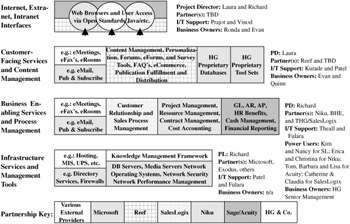Building a Final Picture of the IT Solution for the Customer
|
| < Day Day Up > |
|
Process templates do not tell the entire story. Your business customers will also benefit from seeing examples of completed templates, case studies of how to employ newly IT-enabled process tools, illustrations of the new business process's end products, and so forth. Some of these components or artifacts already exist and need only be appended to the IT process reengineering documentation. Others may exist, however, only as tacit (i.e., undocumented) knowledge, garnered as part of the business analyst's labors and interactions with business unit personnel. Here, the enterprise will require some incentive that encourages in-house experts to convert their experiences to sharable knowledge assets. The IT project team can provide support for these individual efforts, as well as the linkages between their outcomes (e.g., the discrete artifacts that they generate) and the overall business process/IT framework.
Even in the best of all possible worlds, only a fraction of useful tacit knowledge will be transferred to more explicit forms. Few organizations have the time or resources to indulge in oral history projects. Instead, the IT project team may, over time, develop IT-enabled exchanges and forums to link information seekers more easily with subject-matter experts. All of these process artifacts and experiences serve as a business process knowledge library to be used by less experienced personnel. In the instance of the solution selling case study, this library of components includes the following:
-
Process templates
-
Market intelligence
-
Selling solution case studies by customer type and product
-
Project scoping tools and illustrations
-
Proposal library
-
Solution selling process discussion forum
-
Directory of solution selling experts (e-mail enabled)
-
Internet training courses
-
Related online publications
As with the other elements of the process mapping effort, this knowledge library component affords valuable input into the design and development of an enabling IT platform.
Finally, to flesh out the actual design of the IT solution, consider a simple approach to translating the business mapping process findings into a more graphical representation of next steps. Exhibit 5 integrates business process steps with roles and responsibilities and the associated enabling technologies. The graphic presents the envisioned IT-enabled business solution as a series of layers. Beginning with a Web interface for customers and enterprise personnel alike, I outline customer-facing, service delivery, and infrastructure layers. Each layer defines the IT project director, external IT partners, internal IT liaisons or support personnel, and the associated business process owner(s). The most complex layer, the service delivery layer, also identifies, by process subcategory, the power users of each IT system. Lastly, the illustration depicts the IT products that must be brought together to deliver the IT solution called for as an outcome of the business process mapping exercise.
Exhibit 5: An IT Road Map for Implementing Business Process Change

|
| < Day Day Up > |
|
EAN: 2147483647
Pages: 132